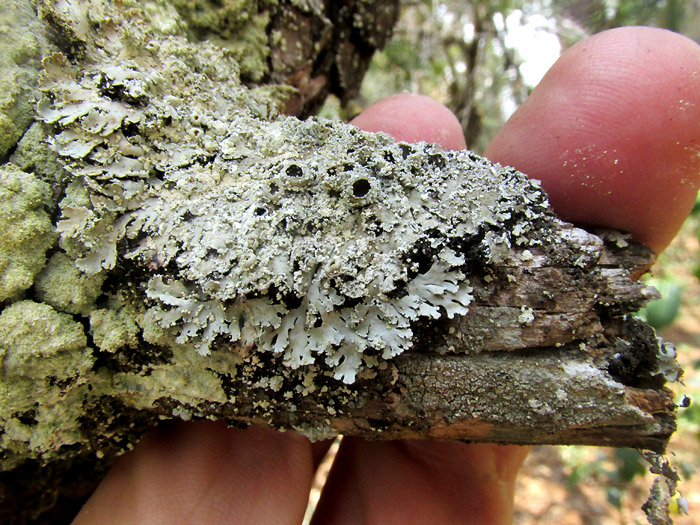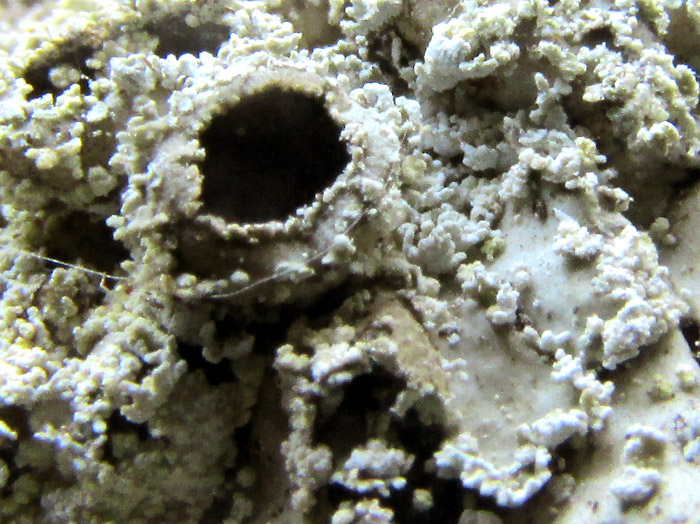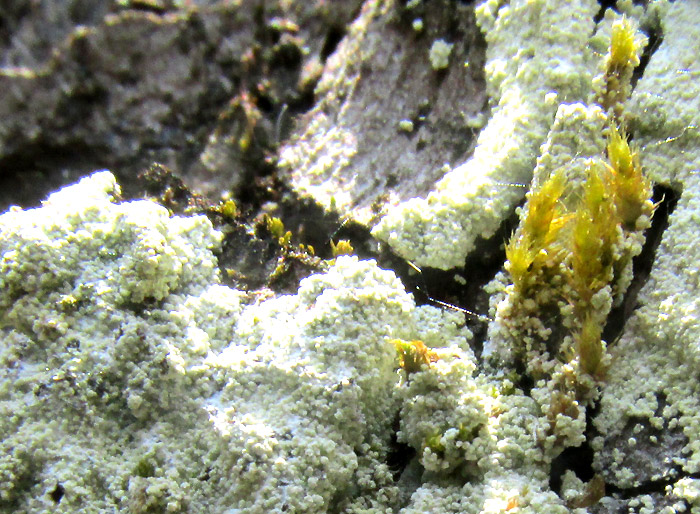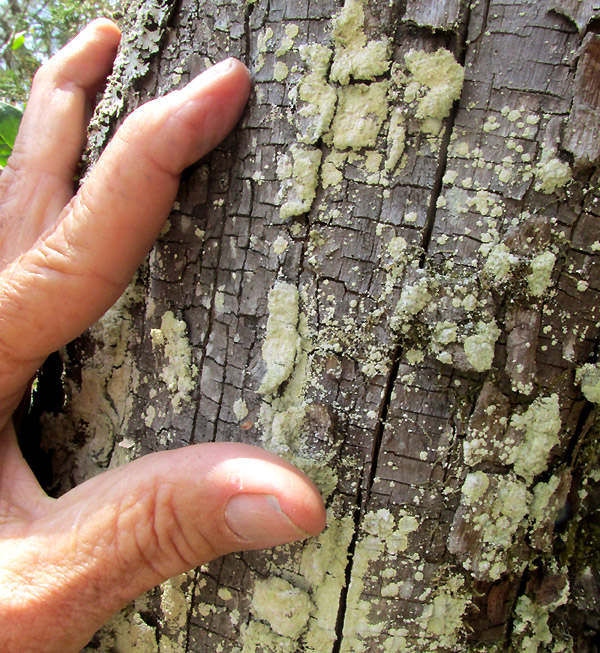Excerpts from Jim Conrad's
Naturalist Newsletter
Entry from field notes dated May 7, 2023, atop hill forested with pines and oaks about 1km east of Curva de la Doctorcilla, on unnamed road connecting Hwy120 and El Doctor; limestone bedrock; elevation ±2650m (8700 ft); Eastern Sierra Madre mountains of east-central Querétaro state, MÉXICO, (N20.88°, W99.62°)
GREENSHIELD LICHEN, FLAVOPARMELIA SOREDIANS

Atop a hill forested with oaks and pines, the latter dead or dying from pine beetles, at eye level on a dying pine's branch stub, the above foliose lichen was doing well. This species was unlike most whitish foliose lichens in that its thalli were smaller, and most of the thalli's surfaces were densely warty, better seen below:

The warts were asexual reproductive structures called soralia. Soralia disintegrate into tiny particles called soredia, which contain cells of photosynthesizing alga and/or cyanobacteria, enmeshed in a matrix of threadlike fungal hyphae. If the soredia end up in a proper environment they can produce new lichens by nonsexual means. Many lichen species produce soralia and soredia, but it's unusual to see such an abundance as seen above.
Also in the above picture, the raised crater with its dark interior is an apothecium, inside which the lichen's fungal element sexually produces spores, similar to how regular mushrooms sexually reproduce spores. Later I would would learn that in this species apothecia are rare, so we're lucky to see them here. These apothecia were helpful during the identification process because their outsides being covered with soralia, their convex interiors were so deep, and their rims were rather thin and irregular with many soralia.
Several lichen species in different genera can be confused with this species -- all whitish, foliose and often conspicuously ornamented with warty soralia. We've already met the Common Greenshield, whose thalli are considerably larger than our present ones'. The Powder-edged Speckled Greenshield bears smaller soredia mostly along thallus margins. Our lichen's details match Internet images labeled as FLAVOPARMELIA SOREDIANS, which appears to have no commonly accepted English name, though species in the genus Flavoparmelia typically are known as greenshields.
As the GBIF Flavoparmelia soredians occurrence map shows, this species is primarily European, with other populations in southern Africa, southern Australia and New Zealand, plus it turns up here and there elsewhere across the world. One was collected in La Malinche National Park, Tlaxcala state east of Mexico City in 1991, and identified by T.H. Nash, a major lichenologist specializing in this species' family, the Parmeliaceae.
The IrishLichens.IE webpage for Flavoparmelia soredians describes this species as occurring in Ireland on well-lit, often dusty trees, fences, roofs and rocks. Dust on a tree might well consist of soredia as well as mineral particles. I think a lichen with such tendencies would be happy on a hilltop tree in a breezy forest in which the canopy has been opened up by dead and dying pines. Maybe Flavoparmelia soredians is benefiting from this disaster.

The above picture was taken about a finger length from the colony's edge. I can't be sure that what's seen above has anything to do with our lichen, but it certainly looks as if this part of the dying pine's bark is covered with warty soralia developed atop a white fungal film not at all forming our lichen's foliose thalli. The warty film appears to be overgrowing green moss stems. I'd hesitate to place this picture and these words on this page, if elsewhere I hadn't seen photos of Flavoparmelia soredians next to similarly warty-film overflows onto mosses, though I find no information describing what's seen above.
About a hand-width farther from the colony, this was appeared:

Doesn't that look like splatterings created by windblown soralia from our lichen? The largest accumulations appear on cracked-bark edges facing the colony, which lies just beyond the picture's right side, suggesting that breezes passing over the colony might have dropped soredia there. I didn't see similar doings on other tree trunks not hosting a thalloid Flavoparmelia soredians colony.
Maybe something interesting and even important is going on here, something going well beyond the simple story of a "foreign" lichen benefiting from a forest's pine beetle disaster.